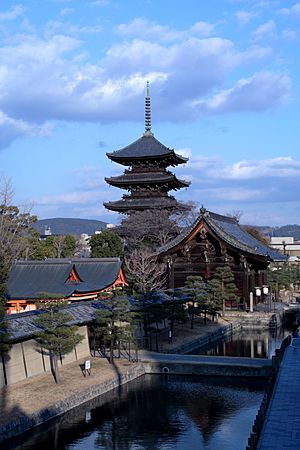Tenchō facts for kids
Tenchō (天長) was a special time period in Japanese history. It was a Japanese era name, also called a nengō (年号), which means "year name." This era came after the Kōnin era and before the Jōwa era.
The Tenchō period lasted for ten years. It started in January 824 and ended in January 834. During this time, two emperors ruled Japan: Emperor Junna and Emperor Ninmyō.
Contents
What Happened During the Tenchō Era?
The Tenchō era saw several important events that shaped Japan.
Key Events in Tenchō 1 (824)
- In 824, the first year of the Tenchō era, Japan experienced a very dry summer. People were worried about the lack of rain.
- A famous Buddhist priest named Kūkai, also known as Kōbō-Daishi, offered special prayers for rain. It is said that his prayers worked, and rain soon followed.
- In the seventh month of Tenchō 1 (824), the former Emperor Heizei passed away. He was 51 years old.
Events in Tenchō 2 and 3 (825-826)
- In the eleventh month of Tenchō 2 (825), the former Emperor Saga celebrated his 40th birthday.
- In the eleventh month of Tenchō 3 (826), Kūkai gave advice to the emperor. He suggested building a tall pagoda near a temple called To-ji in Kyoto.
The Kōnin-Jōgan Period
The Tenchō era was part of a larger historical period called Kōnin-jōgan. This longer period lasted from 810 to 877. During the Kōnin-jōgan period, Buddhism and various forms of art became very important in Japan.
Learn More About Japanese History
Images for kids
See also
 In Spanish: Tenchō para niños
In Spanish: Tenchō para niños

All content from Kiddle encyclopedia articles (including the article images and facts) can be freely used under Attribution-ShareAlike license, unless stated otherwise. Cite this article:
Tenchō Facts for Kids. Kiddle Encyclopedia.


